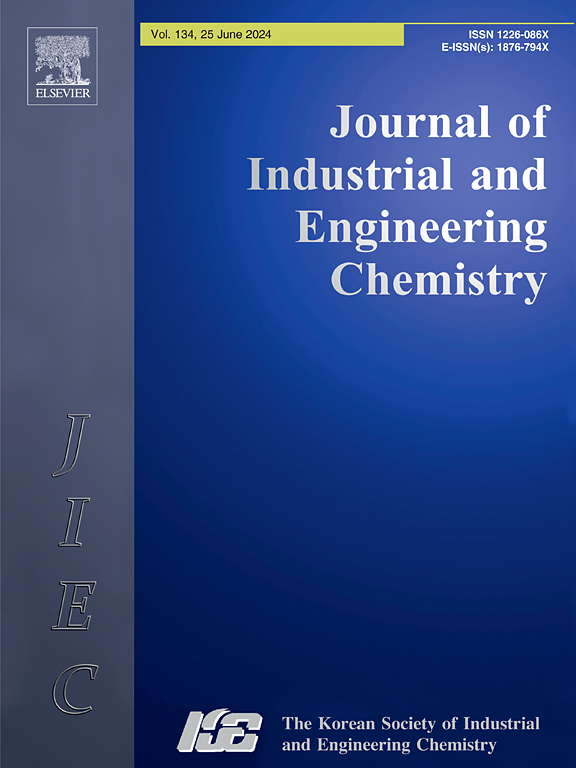Magnetically separable quaternary g-C3N4/Fe3O4/AgBr/rGO nanocomposite for enhanced photocatalytic degradation of ofloxacin in water under visible light irradiation
IF 5.9
3区 工程技术
Q1 CHEMISTRY, MULTIDISCIPLINARY
Journal of Industrial and Engineering Chemistry
Pub Date : 2024-10-25
DOI:10.1016/j.jiec.2024.10.051
引用次数: 0
Abstract
Novel photocatalytic-magnetic hybrid quaternary nanocomposite (g-C3N4/Fe3O4/AgBr/rGO) was successfully synthesized for the first time via ultrasonication-assisted wet chemistry technique. The nanocomposite was characterized using various advanced characterization techniques and its visible light photocatalytic performance was analyzed by using ofloxacin (OFL) as target pollutant. The photocatalytic degradation efficiency was 100 % under conditions (pH 6.65, 0.1 g/L nanocomposite and 10 mg/L OFL) in 5 h. The pseudo-first-order kinetic constant of g-C3N4/Fe3O4/AgBr/rGO was as high as 1.1832 h−1. Evaluation of different catalysts, catalyst dosage, initial concentrations of OFL and initial solution pH have been studied. Based on the scavenging tests, benzoquinone (BQ) significantly decreased the removal efficiency of OFL to 41.4 %, indicating that ![]() O2− served as the dominant radical involved in the reaction. More importantly, after undergoing five cycles, the g-C3N4/Fe3O4/AgBr/rGO nanocomposite demonstrated robust stability and was effectively separated from the solution through magnetic means. The remarkable performance of g-C3N4/Fe3O4/AgBr/rGO is linked to substantial utilization of visible light and facilitation of Z-scheme heterojunctions, thereby facilitating charge separation. The quaternary nanocomposite can be expected to have tremendous potential for the degradation of emerging organic pollutants. Thus, it is favorable for practical application in water and wastewater treatment.
O2− served as the dominant radical involved in the reaction. More importantly, after undergoing five cycles, the g-C3N4/Fe3O4/AgBr/rGO nanocomposite demonstrated robust stability and was effectively separated from the solution through magnetic means. The remarkable performance of g-C3N4/Fe3O4/AgBr/rGO is linked to substantial utilization of visible light and facilitation of Z-scheme heterojunctions, thereby facilitating charge separation. The quaternary nanocomposite can be expected to have tremendous potential for the degradation of emerging organic pollutants. Thus, it is favorable for practical application in water and wastewater treatment.

求助全文
约1分钟内获得全文
求助全文
来源期刊
CiteScore
10.40
自引率
6.60%
发文量
639
审稿时长
29 days
期刊介绍:
Journal of Industrial and Engineering Chemistry is published monthly in English by the Korean Society of Industrial and Engineering Chemistry. JIEC brings together multidisciplinary interests in one journal and is to disseminate information on all aspects of research and development in industrial and engineering chemistry. Contributions in the form of research articles, short communications, notes and reviews are considered for publication. The editors welcome original contributions that have not been and are not to be published elsewhere. Instruction to authors and a manuscript submissions form are printed at the end of each issue. Bulk reprints of individual articles can be ordered. This publication is partially supported by Korea Research Foundation and the Korean Federation of Science and Technology Societies.

 求助内容:
求助内容: 应助结果提醒方式:
应助结果提醒方式:


